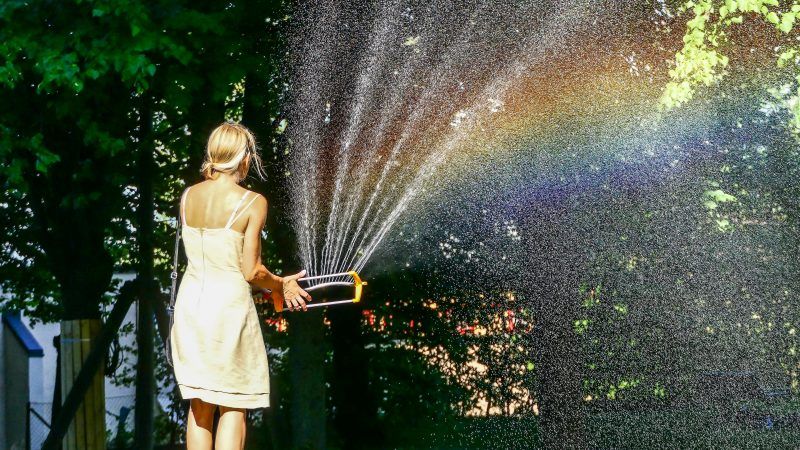How a Fake Rationing Scare Highlighted the Absurdity of California's Actual Water Policies
No, Californians aren't banned from showering and doing laundry on the same day. But the fact that so many people believed that lie says something about how insane the state's real water laws are.

Stamping out incorrect social-media information is like trying to halt those computer viruses that multiply bad files every time you close one. You can sometimes convince someone that the story isn't quite right—only to see it pop up on myriad other feeds. After trying to serve as the "truth police" recently, I finally gave up. There are so many real problems to worry about, but lots of people seem determined to be upset by bogus ones.
The specific story involved water rationing. Former Gov. Jerry Brown signed two conservation-related laws in 2018 that were supposedly going into effect on Jan. 1. According to various social-media and blog posts, the new laws banned Californians from showering and doing laundry on the same day. Apparently, water inspectors would monitor each person's water usage—and impose fines of $1,000 a day on water-wasting scofflaws.
In reality, the laws do not impose any such individual water limits. They "set water efficiency standards for utilities to follow in the decades to come," explained The Sacramento Bee. The 55-gallon daily standards are systemwide average targets (by 2023). Any fines would come from the agencies, so ratepayers could technically be on the hook—but only in an indirect way. The allotments are close to the water levels Californians typically use in a day, anyway.
Nevertheless, it's obvious why this fake news spread faster than water flowing over Oroville Dam's collapsing spillway. It was yet another example of California's wacky progressive politics, and the way lawmakers force residents to change their lives in the name of environmental uplift. Because the information was inaccurate, liberal wonks could easily dismiss the hullaballoo as a conspiracy theory with no connection to reality.
Yet despite the story's bogus claims, conservatives are onto something serious—namely, a state water policy that prioritizes environmental interests over human uses, and that ultimately could lead to the kind of rationing that some people wrongly believed was happening now. The outrage is California policy makers have time to deal with a coming water crisis, but are doing little to avert it. Many seem almost eager for a world of rationing and limits.
The state's historic drought is over, but Gov. Gavin Newsom is pushing a conservation-heavy approach to the water crisis and even is suing to stop the Trump administration's plan to release more water for farms. California's lawmakers haven't built serious new water infrastructure in decades, since the time when the state's population was roughly half its current size.
If you don't build freeways, you shouldn't wonder why the roads are constantly jammed. If you don't build water storage, you shouldn't wonder why the reservoirs are empty during a drought. California officials don't do much of either, no matter how many tax increases voters approve.
Depending on whose statistics one uses, between 48 percent and 65 percent of California's water flows unimpeded to the Pacific Ocean. Instead of building new dams to capture water during wet years, California is, for instance, engaged in the largest dam-busting project in the nation—as it plans to demolish some dams on the Klamath River along the Oregon border.
In the midst of the drought, state and federal officials were depleting reservoirs to help a few salmon swim toward the Pacific (where they're eaten by bass on the way). That epitomizes the state's water policies—a constant push for "pulse flows," and less emphasis on saving water for cities and farms. Californians have passed multiple water bonds over the past few years, but very little of it funds new storage. In fact, recent bond money is going to help tear down those Klamath dams, thus reducing storage.
The 602-foot Shasta Dam in the far north was actually designed to reach 800 feet. A plan to raise it a mere 18.5 feet—providing enough water to fill two-thirds of Folsom Lake—has been scuttled after steadfast opposition from environmentalists and state officials. These policies aren't even helping fish populations, but serve as a handy excuse to always deprive Californians of the water that helps our communities thrive.
"Droughts are nature's fault," said U.S. Rep. Tom McClintock (R–Calif.). "But water shortages are our fault. They are a deliberate choice we made in the 1970s when we made the construction of new reservoirs endlessly time-consuming and ultimately cost prohibitive."
Ultimately, we can pursue water abundance or scarcity. That Bee story rebutting the water-rationing scare quotes a State Water Resources Control Board official who thinks a target of only 40 to 45 gallons a person is more reasonable. That gives the game away. The state can keep lowering the targets until there's no choice but to ration water.
Sure, those social-media posts were wrong to suggest that water-rationing policies already have arrived in California. But unless state officials take a different approach to water policy, that day may be coming sooner than we think.
This column was first published in the Orange County Register.


Show Comments (27)